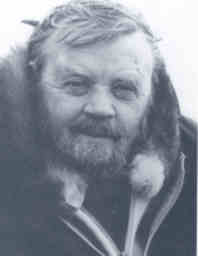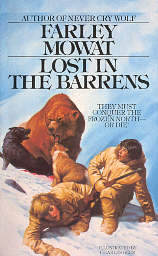Clearly this mound of rocks was part of a Viking settlement. Later Jamie recovered a small sheet of lead with
runic characters on it. When Awasin joined him, they also found a human skull which freaked out the superstitious
Indian boy. They pushed the weapons back into the crevice and broke camp. At one point the two boys were
mistaken from a distance as Eskimos by the very hunters they were trying to reach, and the Indians who could have
been their salvation "slid silently past the place where the two boys slept by the dead ashes of their fire." The boys
had neglected to leave some sign that they were not Eskimos, and their adventure continued into the barrens the next
day.
They found the deer fence which warriors had erected to allow them to survive the mass migration of the
caribou while hunting them from up close. They make it across the frozen lake and the hidden valley and discovered
a highway which consisted of a river bed turned upside down. How can a river bed of gravel travel up and down
over hills? Imagine a huge glacier of thousands of feet thick. Over its surface when the glaciers began to melt, rivers
would run across them, creating grooves in the ice and depositing gravel. Later as the ice age ended, the glaciers
would melt away completely and the gravel in the icy river beds would fall across the hilly terrain below leaving a
stony trail which ran up and down hills. These trails are called eskers. For Jamie and Awasin these were the quickest
routes they could take across land.
[page 104] Some are hundreds of miles long and they may even cross mountain ranges in
the same way that the Great Wall of China snakes its way up and down mountains. In
places the eskers drive straight across big lakes like causeways. They are the natural
highways of the arctic plains.
Finally the boys spot the great migration of deer where they are waiting. They know they will have only day to
shoot as much food as possible to help them survive the winter on the plain which will soon become a barren waste,
void of vegetation or animal life. Jamie's eyes kept focused on the ridge for signs of life.
[page 107] Suddenly the crest of the ridge underwent an amazing change. It was as though
a forest had sprouted on that naked hill. Thousands upon thousands of twisting branches
seemed to be springing from the rocky ground and waving gently in the breeze. Jamie knew
the trees were the antlers of the deer coming up the far slope. He pressed the butt of the
rifle tightly against his shoulder.
Soon Jamie was firing at the deer passing him as he stood on a large rock and the teeming herd poured past
him. Within a half hour he and Awasin needed to kill enough deer to see them through the winter. In a nearby
location, Awasin was killing deer with his homemade spear and getting blood splattered all over him. After he
stopped shooting, Jamie rested on his rock and surveyed the spectacle around him.
[page 108, 190] The endless movement of the deer began to hypnotize him. He sat still as
a statue while the tremendous impact of the spectacle gradually registered on his mind.
The heaving, seething sea of antlers and brown backs flowed on. Time passed like light.
The flood poured on . . .
It must have been several hours later that Jamie looked down from his perch and
saw no living deer. Instead he saw the bloody figure of Awasin walking toward him. Stiffly
Jamie lowered himself from the rocks.
The world was very still and motionless.
They met beneath the rock pile and said not a word to each other. Silently they
walked back to their camp, each alone with his own thoughts. Never, while they lived,
would they forget this day for they had looked deeply into one the great mysteries of
the animal world.
Once they had cleaned and secured their large stash of deer meat in several rock covered pits, Jamie and
Awasin began making them a log cabin which would protect them from the wintery blasts to come. To do that they
required rope, much more than they had available to them. Awasin set about making some babiche or Indian rope
to lash the logs securely together. How can one make a continuous rope out of a pelt of hide? Awasin showed Jamie
how to do it.
[page 114, 115] First of all he took a deer hid and scraped and cut all the hair from it. Next
he soaked it till it was soft, pegged it out on the ground, and made a slit in the edge near
one corner. From here he began a spiral knife-cut that went round and round, cutting off
a strip about an inch in width. By the time Awasin had reached the center of the hide, he
had a piece of skin and inch wide and almost a hundred feet in length.
He soaked this for an hour in warm water, then took it in his hands and rolled it
between his palms, starting at one end and working along to the other. Back and forth he
went, and as the hide slowly dried it began to form a round, rawhide rope a quarter inch
thick and as strong as the best hemp line.
When a piece was needed, they soaked it until it was soft, then tied the logs in
place. As the rawhide dried it shrank, and the joint became as tight as if it had been spiked.
The other part of winter survival required clothing for them which they made from deer hide. The hoods of their
handmade parkas were lacking only one thing, wolf or wolverine fur to edge them, Awasin said.
[page 12] Why is wolf fur so special?" Jamie wanted to know.
Because it and wolverine fur are the only kinds your breath won't form ice on,"
Awasin answered patiently. "Any other kind of fur ices up and may stick to you and freeze
your face."
There was one missing piece of survival gear the boys needed: a pack animal. The small reindeer which had
adopted them would not be big enough to help them, but it helped them in a different way. Oatanak as they had
named the fawn, got separated from them and became a meal for some wolves. But as the two animals got closer,
the boys were amazed to find them to be very large Huskies and Awasin immediately recognized the possibility of
the acquiring the two as sled dogs. Building a trap and luring the dogs in it with meat, they captured the animals, but
were unable to get outside their cabin because the trap utilized the cabin door as one side. They were forced to
become friends with the dogs or else. Soon the dogs were sleeping in the cabin and pulling their sled with their
caches of meat from their rock covered pits. Mainly the dogs dispelled the two boys' depressive loneliness.
[page 151] Now the loss of little Otanak was made good. The presence fo the dogs in the camp dispelled the loneliness of the land as nothing else could have done. The boys had a fresh interest in life,
and they devoted themselves to the Huskies, who if all went well might be the means of delivering
them from the winter Barrens.
With their sled dogs, the boys loaded up their supplies on the sled and began to make time heading south over
the frozen waste. No more slogging through muskegs, no more wearisome paddling against a current, no more
treacherous rapids to negotiate, just a brisk ride or walk alongside the sled as the dogs pulled their survival gear.
Ironically, it was a tribe of the feared and avoided Eskimos who located the boys during their trek southward and
helped them return to camp, creating a reconciliation of the long separated residents of the sub-arctic expanses.
Finding the Stone House, witnessing the great caribou migration, building a log cabin, outwitting the wily wolverines,
surviving a huge Grizzly Bear's attack, patching up relations between the Eksimos and Indians, and arriving home
safely the two boys' adventures in the Far North have made for a great Summer read in the Deep South.





